India
Sanchi
The Buddhist Monuments at Sanchi represent the remains of an ancient major Buddhist sanctuary.
The site is known for its sculptured decorative work in stone of high artistic quality, notably in Stupa no. 1 and 3. It also holds the enshrined remains of two chief disciples of Buddha, and therefore has stayed a place of pilgrimage. The site has ruins of about 50 monuments, among them are three large stupas, temples, a monastery and monolithic pillars.
Community Perspective: The main stupa at the hilltop is definitely the most eye-catching sight here. The site can be visited as a day trip from Bhopal, combined with the Rock Shelters of Bhimbetka. The best time for photography is in the late afternoon.
Site Info
Official Information
- Full Name
- Buddhist Monuments at Sanchi (ID: 524)
- Country
- India
- Status
-
Inscribed 1989
Site history
History of Sanchi
- 1989: Inscribed
- Inscribed
- Type
- Cultural
- Criteria
- i
- ii
- iii
- iv
- vi
Links
- UNESCO
- whc.unesco.org
- Official
-
- asibhopal.nic.in — Archaeological Survey of India
All Links
UNESCO.org
- whc.unesco.org — whc.unesco.org/
Official Website
- asibhopal.nic.in — Archaeological Survey of India
News Article
- Aug. 16, 2014 timesofindia.indiatimes.com — Security cordon around Sanchi stupa after IM threat
- Nov. 20, 2011 timesofindia.indiatimes.com — Sanchi becomes blind-friendly
Community Information
- Community Category
- Religious structure: Buddhist
Travel Information
Recent Connections
-
Incorrect UNESCO 'Number of locations'
The official map clearly shows 2 separa…
-
Perfect Inscriptions
1989 -
Griffins
At stupa No. 2See en.wikipedia.org
Connections of Sanchi
- Individual People
-
-
Sir John Marshall
Excavated 1912-19 under Marshall. Concentrated on the Great Stupa -
Emperor Ashoka
Gt Stupa. "Asoka, whose queen was from the neighboring town of Vidisha, founded, or at least embellished, a Buddhist sanctuary located at Sanchi. He also had a stone column more than 12 m high erected with his edicts carved on it" (AB review)
-
- Trivia
-
-
Total Solar Eclipse since Inscription
21/22 July, 2009 -
In Video Games
Civilization VII -
Built elsewhere as a full size replica
Outdoor space of Berlin's Humboldt Forum museum complex: Sanchi East GateSee www.dw.com
-
On Banknotes
200 rupees 2016See en.wikipedia.org
-
- Architecture
-
-
Domes
Great Stupa -
Greco-Buddhist Art
"Although the initial craftsmen for stone reliefs in Sanchi seem to have come from Gandhara, with the first reliefs being carved at Sanchi Stupa No.2 circa 115 BCE,[27] the art of Sanchi thereafter developed considerably in the 1st century BCE/CE and is thought to predate the blooming of the Greco-Buddhist art of Gandhara, which went on to flourish until around the 4th century CE. The art of Sanchi is thus considered as the ancestor of the didactic forms of Buddhist art that would follow, such as the art of Gandhara" ... "The presence of Greeks at or near Sanchi at the time is known (Indo-Greek ambassador Heliodorus at Vidisha c. 100 BCE, the Greek-like foreigners illustrated at Sanchi worshiping the Great Stupa, or the Greek "Yavana" devotees who had dedicatory inscriptions made at Sanchi[85]), but more precise details about exchanges or possible routes of transmission are elusive."See en.wikipedia.org
-
- World Heritage Process
-
-
Incorrect UNESCO 'Number of locations'
The official map clearly shows 2 separate areas instead of 1. For some reason, they made them not contiguous.
-
Perfect Inscriptions
1989
-
- Religion and Belief
-
-
Stupa
-
Introduction of Buddhism
criteria vi "Sanchi is one of the oldest extant Buddhist sanctuaries. Although Buddha never visited the site during any of his former lives or during his earthly existence." (OUV) -
Buddhist sites in non-Buddhist countries
-
Griffins
At stupa No. 2See en.wikipedia.org
-
- Human Activity
-
-
Erotic art
"The earliest known fusion of sexual and religious imagery in stone in the subcontinent is on Buddhist monuments at Sanchi and Bharhut (second century BCE). Even though these earliest depictions were tame— non-erotic and non-amorous—it’s safe to say that the inspiration for them did not come from the sex-negative Buddha. Rather, it arose from the syncretic milieu of the builders and their simultaneous embrace of many folk cults, including of yakshis and Sri, alongside the teachings of the Buddha."See www.himalmag.com
-
Petrosomatoglyphs
Stupa 1 Northern Gateway: "The bottom of the pillar face has two footprints of the Buddha with a wheel of the Law on their sole"See en.wikipedia.org
-
- Constructions
-
-
Pillars
Quote from ICOMOS evaluation "Asoka, ....... also had a stone column more than 12 m high erected with his edicts carved on it. "
-
- Timeline
-
-
Built in the 3rd century BC
Stupa no. 1
-
- Visiting conditions
-
-
Foreigner prices
Citizens of India and visitors of SAARC (Bangladesh, Nepal, Bhutan, Sri Lanka, Pakistan, Maldives and Afghanistan) and BIMSTEC Countries (Bangladesh, Nepal, Bhutan, Sri Lanka, Thailand and Myanmar) - Rs.30 per head. Others: Rs. 500/- per headSee asi.nic.in
-
News
- timesofindia.indiatimes.com 08/16/2014
- Security cordon around Sanchi stup…
- timesofindia.indiatimes.com 11/20/2011
- Sanchi becomes blind-friendly
Recent Visitors
Visitors of Sanchi
- Alberto Rodriguez Gutierrez
- Alexander Lehmann
- Artur Anuszewski
- Aspasia
- Atila Ege
- Bamse
- Bernard Joseph Esposo Guerrero
- Bin
- Cheryl
- Chinmaya
- Christer Sundberg
- Clyde
- David Marton
- Dimitar Krastev
- Els Slots
- Erik Jelinek
- Fan Yibo
- Harry Mitsidis
- Iain Jackson
- Jarek Pokrzywnicki
- Jezza
- Joel on the Road
- Kjlauer
- Knut
- Kurt Lauer
- Ludvan
- Lukasz Palczewski
- Luke LOU
- Mahuhe
- marcel staron
- MaYumin
- Michael Turtle
- Mikko
- Mkandasa
- Morodhi
- Nihal Ege
- Patrik
- Philipp Peterer
- Reza
- Roman Bruehwiler
- Sergio Arjona
- Shandos Cleaver
- Solivagant
- Stanislaw Warwas
- Szucs Tamas
- Taotao Chen
- Tarquinio_Superbo
- Thomas Buechler
- Thomas van der Walt
- Tim Allen
- Vanessa Buechler
- Vincent Cheung
- Waxwing
- Wojciech Fedoruk
- Zoë Sheng
- Zos M
Community Reviews
Show full reviews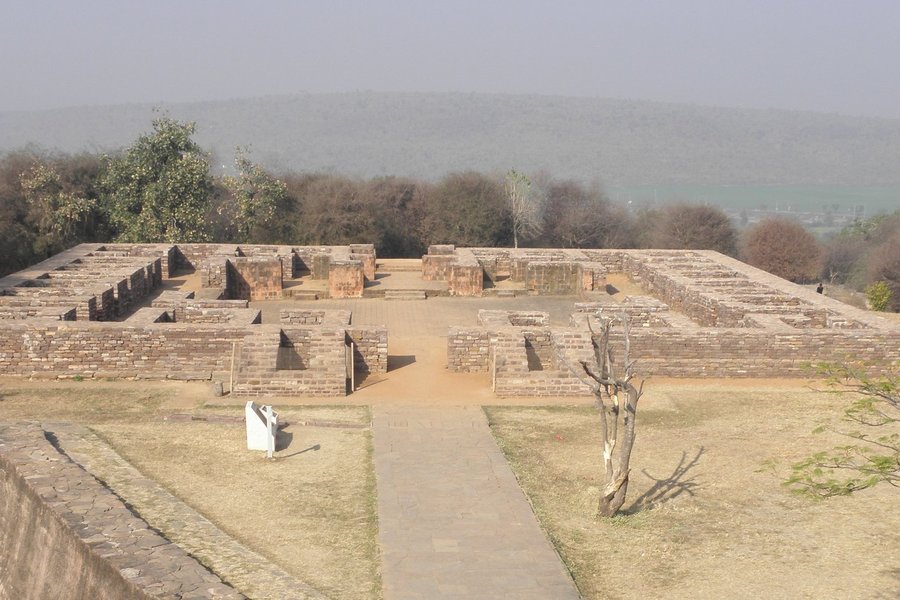
Visited this WHS on the same day I visited another WHS, Bhimbetka caves. At morning 9, except myself and another Bengali Family, site was empty. No English guides were available at that time. Used wikipedia as my guide material.
Wikipedia has excellent information about the Toranas, which have carvings in the stones as if they are carved on wood. Such precision. Lord Buddha is represented as different animals, Bodhi Tree, stupas in those carvings(Toranas).
There are some old non functioning temples too were there. Spent close to 2 hours in the site. This site is must visit for any history/architecture lovers.
Keep reading 0 comments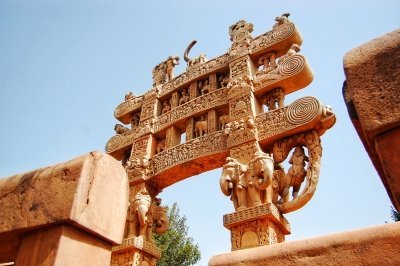
Sanchi is a pleasant site to visit and going there is convenient too from Bhopal. I went to this WHS via train, and came back on a bus, both took less than an hour. The Great Stupa is surprisingly the most well-preserved structure there and it could, in my opinion, easily have been a WHS on its own as a single monument for its history and high level or artistry. The elevated site is relatively large with various ruins of other Buddhist temples and shrines. I enjoyed some good 2 hours on site, absorbing all the details, of which some date back to 300BC -- it is after all the oldest standing stone structure in the subcontinent. The museum at the base is also interesting, most especially the stone pillars with erotic scenes displayed in the garden.
The Sanchi stupa is similar to other great stupas in a way that it was built on top of a hill. It might even have been the precedent for such planning and layout, which was applied to the much younger Borobudur, Wat Mahathat in southern Thailand, and even Dambulla.
Keep reading 0 comments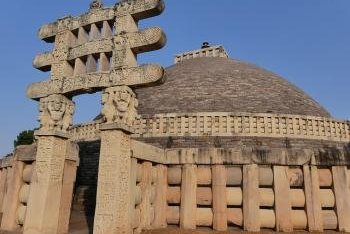
I visited this WHS in November 2016. It is an hour away from Bhopal and two hours away from Bhimbetka.
The Great Stupa is the oldest stone structure in India and the main highlight of this stupa as well as of Stupa 3 are the elaborately carved toranas or ornamental gateways.
They are truly of OUV and almost in pristine condition. There are also other minor remains of pillars, temples and unfinished stupas as well as an informative museum down hill from the stupas so allow at least 3 hours to visit thoroughly.
There are 2 UNESCO inscription plaques (one in brass similar to the others in Karnataka and one in marble) near the entrance to the site. Best time for photography is in the late afternoon.
Keep reading 0 comments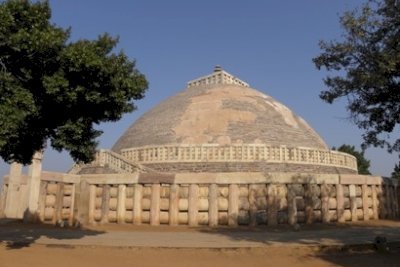
I was the only visitor here, having arrived already at 8.50 a.m. after a 7.30 start from Bhopal. The 250rs entry ticket has to be bought at the base of the hill, where there is also an archeological museum (which I did not visit). Then a steep uphill climb follows, fortunately I had a car to take me. There was no one to check my ticket at the gate. But I did not surprise the suddenly appearing security lady - I had to open my bag to show nothing was in it besides a bottle of water, a notebook and a pen.
The main stupa at the hilltop is definitely the most eye-catching sight here. You’ll have to come in the late afternoon however to get really great pictures of it. The stupa looks like a stupa always does, a perfect dome. Wonderful are its four sculptured gateways, they are the main reason for turning this site into a WHS. Taking their age into consideration, the quality of the sculptures is really unique.
The base of the stupa also has inscriptions of donations given by devotees – a practice that obviously predates the namedropping at western museum collections nowadays. The four gateways lead to a Buddha statue each. Although most of the on-site carvings are in perfect condition, 3 out of 4 Buddhas have their heads smashed in. Probably not a coincidence. The stupa has two ambulatories, by which I “climbed” it.
There are a number of …
Keep reading 0 comments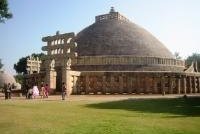
North of Bhopal, on a small hilltop is some of the oldest and most interesting Buddhist sites in India – the monuments of Sanchi. History tells that when emperor Ashoka once embraced Buddhism he built his first “stupa” at Sanchi and later several more, as well as other religious structures. Some centuries later, when Buddhism was slowly absorbed into Hinduism, the site was forgotten and not rediscovered until 1818 by the Brittish army.
The gates to the stupas – the “toranas” are the real highlight of Sanchi. Absolutely brilliantly carved stone depicts episodes of Buddas life and it is said that the toranas are possibly the best and finest Buddhist art in India.
Keep reading 0 comments
